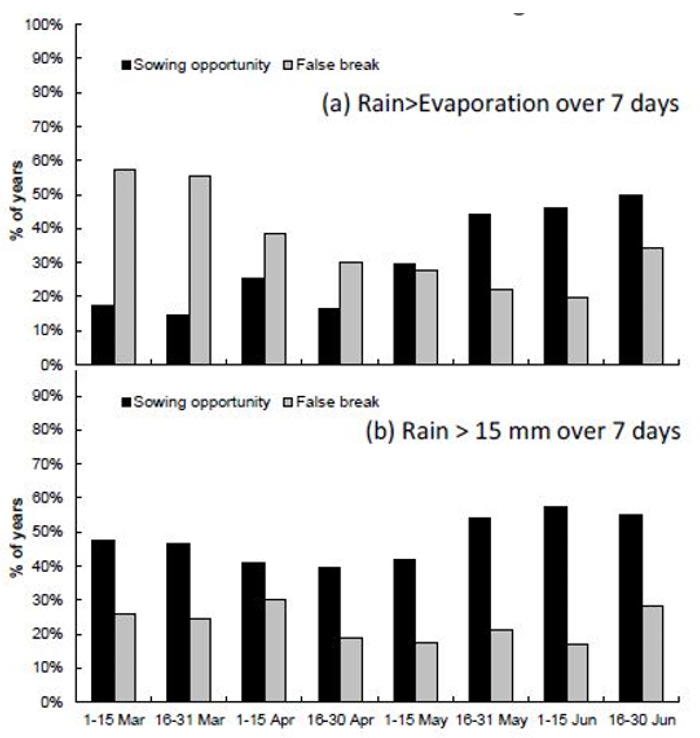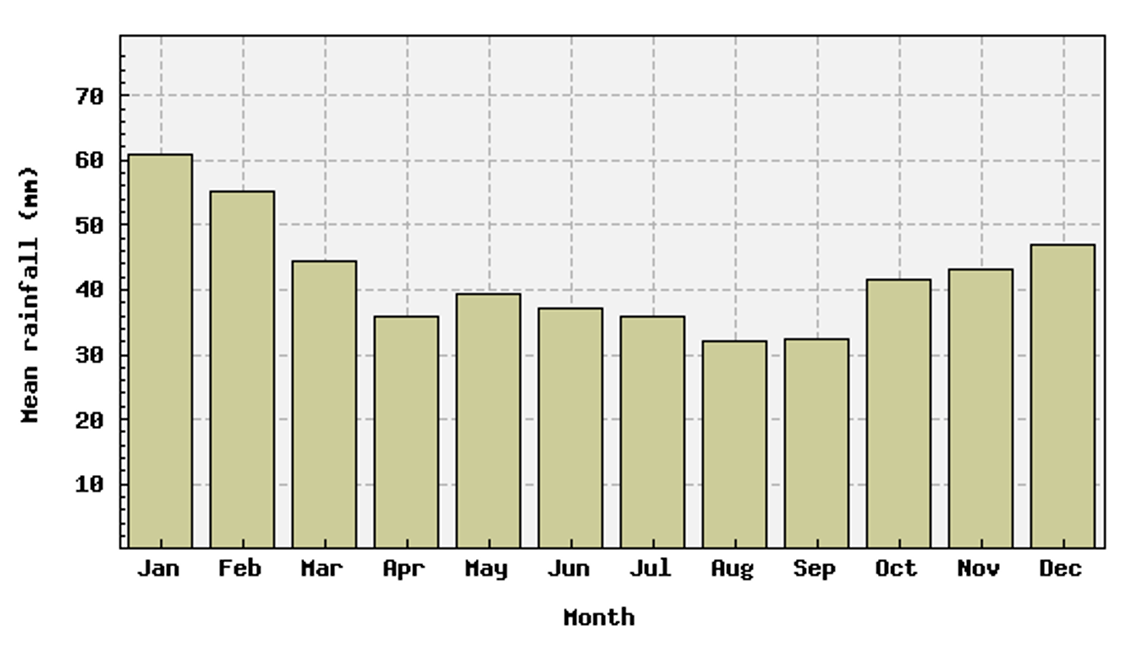The economics and practicalities of dual purpose crops in central/northern NSW
Author: David Harbison (D R Agriculture) | Date: 28 Feb 2024
Take home message
- Fallow management and stored water are critical for grazing dual purpose crops and improve the likelihood of early sowing
- Timely sowing creates ‘grazing days’
- Maximising grazing efficiency, stocking rates, land area and class of stock increases the probability of greater profits
- Increased profitability per hectare gross margin by comparison to grain only situations.
Introduction
Dual-purpose cropping in northern NSW, and the more northern areas of central NSW is more challenging than in southern NSW due to reliance on summer rainfall which typically experiences greater variability in distribution and higher evaporation rates. However, research conducted to evaluate farming systems within the northern region showed that the potential gross margin returns can be increased up to $400/ha for mixed systems comprised of grain and grazing compared to grain only systems (Bell, 2016). Driving the ‘top end’ of such returns are dependent on making the right agronomic decisions including but not limited to sowing date, selection of dual purpose or long season cultivar, plant nutrition, grazing management (both stock density and timing) and ‘lock up date’.
In addition to the potential individual paddock gross margin benefits, there are wider whole-farm benefits offered by dual purpose crops. These include risk management, widening of the sowing window, providing high quality late autumn/winter dry matter crop flexibility (grazing out or conservation as hay or grain production), and ‘rest’, or the option of deferring the grazing of grass/legume based pastures areas while stock are on crop. With an increase in the size of cropping machinery over the last 20–30 years to benefit the productivity of the grains’ operations (including labour efficiency), much of the livestock infrastructure has been reduced or removed. So, what limitations does this place on the uptake of dual purpose crops by grain growers for livestock production? In short, many paddocks are now too large for ‘best practice’ grazing. Water points are often minimal and provide an insufficient amount of quality water suitable for livestock, or alternatively the number of stock required to provide efficient grazing would be very large thereby creating its own sub-set of management issues in terms of infrastructure and labour (Harbison, 2020).
Practicalities
The maximum paddock size for grazing and cropping is largely dependent on the practicalities of providing adequate water for livestock and an acceptable level of crop utilisation. Growers with paddocks less than 40 ha in area have found it is far easier to adjust grazing management to maximise dry matter utilisation over a shorter period of time, whilst leaving sufficient residual biomass so as not to impede re-growth and crop yield (Kirkegaard et al. 2022; Sprague et al. 2016).
When selecting which dual purpose cultivar to use, it is important to consider the potential grain value at harvest as well as the likely dry matter production available for grazing. Sowing early, or ‘earlier’ than common practice, is driven largely by fallow efficiency, stored water and the ‘likelihood’ of a sowing opportunity. Bell (2016) provides modelled data from Walgett NSW, with two approaches to a ‘sowing opportunity’. The first is when the rain received exceeds the potential evaporation over 7 days, and the second is based on a threshold of 15 mm of rain occurring over a 7-day period (Figure 1). The analysis here using the first approach shows that sowing any earlier than 1 May is likely to result in a false break (i.e. % of years which incur a false break is greater than the sowing opportunity), whilst the second approach shows that planting could occur as early as 1 March and consequently has much earlier sowing opportunities, but likely greater risk.
In an approach to limit the risk of a false break, conserving fallow rainfall is critical. The Coonamble long-term rainfall pattern (Figure 2) shows the importance of capturing summer rainfall to generate an early sowing opportunity. If the second ‘opportunity to sow’ approach is combined with an adequate amount of stored moisture (e.g., plant available water (PAW) greater than 150 mm), the potential success of dual-purpose crops increases significantly.
Figure 1. Frequency of a sowing opportunity in fortnightly windows from 1 March to 30 June at Walgett.
Sowing opportunities were calculated as the % of years when either (a) rainfall exceeded potential evaporation over a 7-day period or (b) 15 mm of rainfall over a 7-day period.
Source; Bell 2016
Figure 2. Coonamble long term (1878 – 2010) average monthly rainfall.
Source; BOM 2024
The early dry matter produced varies with species and cultivar, soil health and fertility. Managing both ensures the best grazing opportunity. While seasonal dry matter data varies significantly each year, anticipated dry matter at the commencement of grazing would generally range from 1500 –2500 kg DM/ha. Much of the research (Kirkegaard et al. 2016, Sprague et al. 2016) reports dry matter yield in ‘grazing days’, thus determining how many livestock, of what class (or DSE equivalent), for how long can be difficult. How likely is a second graze? Assumptions are made to convert dry matter yield into red meat. The decision when to ‘close the gate’ or ‘shut up’ should be driven by the physiology of the plant and stage of growth and residual biomass, and not by a date on a calendar. If maximising grain yield is a key target, it is imperative to get this destocking decision right. Managing all these challenges is critical to achieve the best grazing efficiency and grain yield which in turn maximises the economic return.
Summary
The grazing window for dual purpose wheat is between the period where the wheat plant is well anchored in the soil and DC31, which is the commencement of stem elongation. Later grazing than DC31 increases the risk of the wheat head being grazed whilst it emerges from the plant base. If grazing young developing wheat heads, there is a significant risk in northern grain belt areas of grain yield penalties. Wheat dry matter will accumulate at 30 to 60 kg/day and early sowing permits maximum dry matter to be accumulated and available for grazing during this window. Crop recovery is important and to facilitate this at least 1500 kg/ha of wheat dry matter should be left after grazing. Good stored soil water, early sowing, and timely removal of livestock stock are key to the biological success of dual purpose crops for good grain yields.
Economics
Market prices of all inputs/outputs determine financial outcomes and the economics of each decision and of the whole farming system. When assessing the economic performance of a mixed farming operation, the grazing component including the ‘value’ of dual purpose crops must be considered. The costs of sowing a crop, be it for grazing and grain, or just straight grain, will be similar. One variable that is likely to change, from a grazing perspective, is nitrogen (N) management. Providing sufficient N ‘up front’ (pre-plant) to maximise dry matter production will contribute to the potential carrying capacity. Whilst not all the ingested N in plant tissue is used for livestock growth, with varying amounts of N returned to the soil as manure and urine, additional N is likely to be needed post destocking to achieve grain yield and protein targets.
Animal liveweight gains on grazing crops for sheep (lamb) and cattle (steer) are regularly quoted at >0.25 kg/day and >1.5 kg/day respectively. There are many cases of improved animal performance when mineral supplementation occurs with grazing cereals, (particularly wheat), and more so in cattle. Cattle can have an ‘adaption’ or ‘lag phase’ period as they are introduced to grazing crops, particularly canola, but once ‘adapted’ perform well. McCormick et al., (2021) report cattle average daily gains of 1.75 kg over the entire grazing period despite a period of ‘adaptation’.
Putting all the above numbers into perspective, if upwards of 30–50 grazing days are achieved and grazing utilisation is at 60%, using stocking rates of 2.5–3 steers/ha can see gross grazing returns of $330–470/ha (at steer pricing of $2.50/kg liveweight). Lamb calculations work out very similar.
Conclusions
The incorporation of dual purpose crops to support livestock for mixed operations can contribute very positively to whole farm income including the central and northern NSW regions. Important to the success of dual purpose crops is making the right agronomic decisions which creates the opportunity to sow ‘early’, with the chosen species/cultivar, grazing efficiently (driven by stock density and paddock size) with the right class of livestock, having access to good quality and quantities of water, making timely destocking/closing the gate decisions and utilising efficient livestock infrastructure all make small steps towards a significant grazing return. As Kirkegaard et al., (2016) highlight, “not leaving enough residual biomass after the last grazing is very damaging in terms of grain recovery”. Do not overgraze, we need to get it right.
References
Bell L (2016) Role and fit for dual‐purpose crops for mitigating risk and optimising profit in low rainfall western grain growing regions. GRDC Grains Research Update.
Bureau of Meteorology (2024). Australian Government
Harbison, D (2020) Wire, water and grazing management in dual purpose crops. GRDC Grains Research Update.
Kirkegaard J, Sprague S, Bell L, Swan T and Dunn M, (2022) Dual-purpose crops – roles, impact and performance in the medium rainfall farming systems. GRDC Grains Research Update.
Kirkegaard J, Sprague S, Lilley J and Bell L (2016) Managing dual-purpose crops to optimise profit from grazing and grain yield. GRDC Grains Research Update.
McCormick J.I, Paulet J.W, Bell L.W, Seymour M, Ryan M.P, and McGrath S.R (2021) Dual-purpose crops: the potential to increase cattle liveweight gains in winter across southern Australia. Animal Production Science, 2021, 61, 1189–1201. CSIRO Publishing. https://doi.org/10.1071/AN19231
Sprague S, Kirkegaard J, Lilley J, Bell L, Hunt J, Swan T, Breust P (2016). Dual purpose crops do they have a fit in your system and how can they be managed to optimise forage and grain production. GRDC Grains Research Update.
Contact details
David Harbison
D R Agriculture Pty Ltd
Molong, NSW 2866
Ph: 0408 820 467
Email: david@dragriculture.com.au
Date published
February 2024
Was this page helpful?
YOUR FEEDBACK


